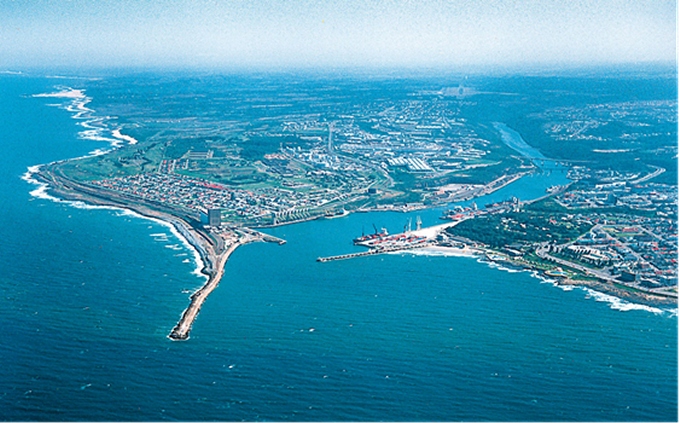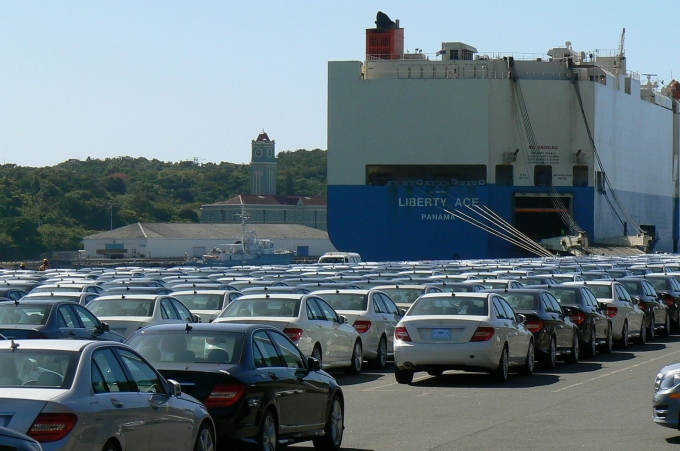Life on the Buffalo River
/East London, Eastern Cape
With our sail down the coast from Durban to East London, we've moved from Kwa-Zulu Natal province to Eastern Cape. The city of East London was founded in 1836 as the result of a survey of the Buffalo River by Royal Navy Lieutenant John Bailie. An old picture illustrates life on Buffalo River in about 1875.
The town logically grew up around the river's mouth. In fact, the whole metro area including surrounding towns and East London as its hub, is now referred to as the “Buffalo City”.
East London is South Africa's only river port and it's a busy one since it's a new car terminal for Mercedes. Huge car carriers move in and out of the port day and night, and the turnaround is quick … sometimes less than a day. In the few days, we've been here, we've seen no less than four car carriers. They load new Mercedes-Benz C-Class cars destined for the USA and the ship is off the dock within hours, their holds loaded with Mercedes consignments to Baltimore, Brunswick and Long Beach.
We've watched the loading process. It's fascinating. Two pick-up trucks run continuously up and down the gangplank. Eight guys drive eight new cars aboard where a pick-up truck is waiting. The truck picks them up and brings them back down to the new car lot and the process starts again. In the meantime, another team of eight guys is in the process of driving eight more cars aboard. We figured this would be a fun job for about a day and then we'd lose interest.
We've got an excellent view of the whole process, but not quite as close as it appears from this picture taken from shore.
Nine of Cups is limited in its exploration of the river since there's a railroad trestle/traffic bridge just ahead of us that would definitely not clear her mast. This unusual double-decker bridge over the river was completed in 1935 and is the only bridge of its type in South Africa.
The Buffalo River Yacht Club, with its local boats trot-moored in front, is located to port just before the bridge. The yacht club will probably be more active towards the end of the week and we're hoping to have a chance to duck in and say hello.
Latimer's Landing, a small complex with a few shops, is to starboard before the bridge. We could hear the strains of a singer and guitarist from the Footprints Restaurant at the Landing when we arrived over the weekend, but during the week, it appears to be closed. The national police also have an office at the Landing. We'll need to file a flight plan (we'd call it a float plan since we float rather than fly, but they call it flight plan) with them before heading out of the port.
The harbor is, of course, on the Indian Ocean just inside the entrance to the river, protected by a large breakwater that keeps the waves and swells at bay. The breakwater, by the way, is lined with huge dolosse, interesting, odd-shaped concrete block creations that remind me of children's jackstones that we played with as kids. We've seen them in other harbors, but didn't realize they were first designed in 1963 right here in East London, by Eric Merrifield, Harbour Engineer. The word “dolo” (singular) seems to be from the Afrikaans origin meaning “knuckle bone”, referring to the shape of the structures.
We haven't anchored in a river in quite awhile. I think our last river anchorage was up the Gordon River in Tasmania and that was actually moored to a decrepit old wharf, not really an anchorage. Hmm … I guess Panama was our last real river anchorage. No matter, here we are now, our first anchorage in months, and it's quite pleasant. The Buffalo is about 78 miles (126km) long and we had thought to explore a bit upriver with the dinghy, but it's been raining cats and dogs. If the sun appears before our next weather window, we might just take a self-guided river cruise up the Buffalo.










